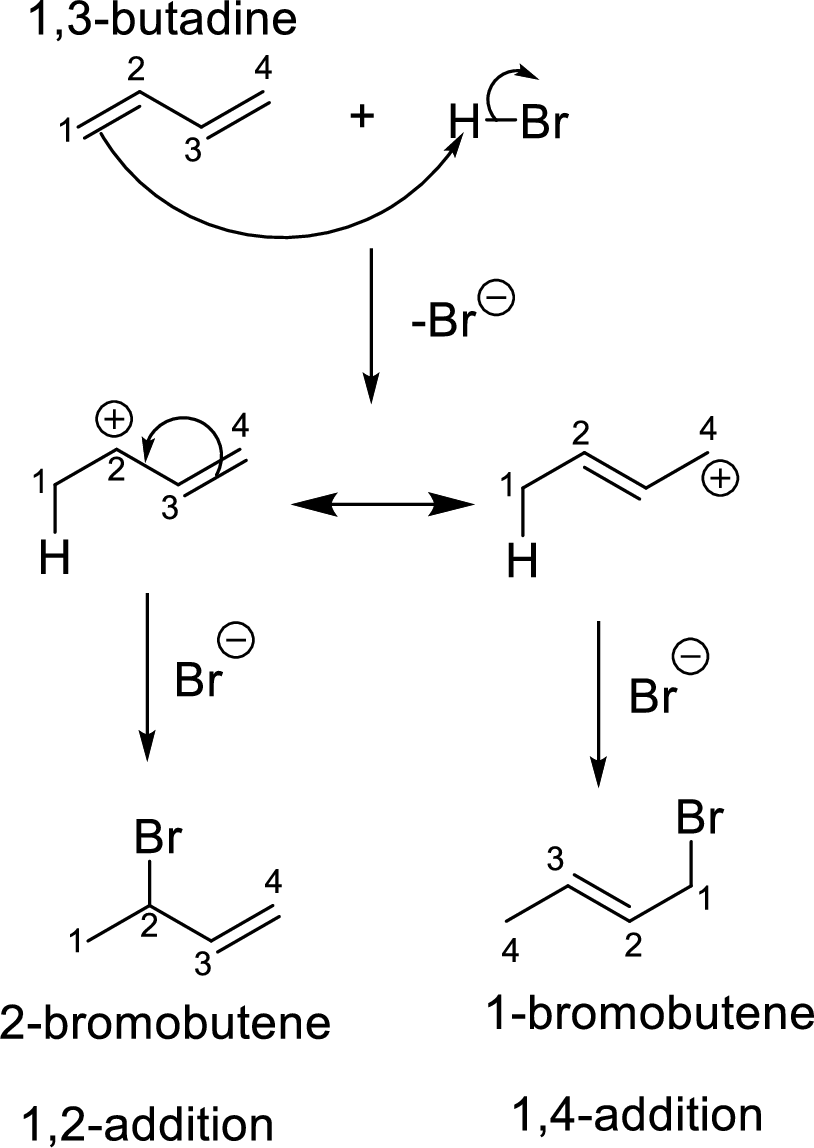
Concept explainers
Interpretation: On addition of one mole of
Concept Introduction:
Addition reaction of dienes:
The diene with a four carbon system is

The constitutional isomers have same molecular formula and different connectivity of the substituents in the same structural formula.
Example:

Trending nowThis is a popular solution!

Chapter 20 Solutions
Organic Chemistry
- Propose a synthesis of the anti-inflammatory drug Ibuprofen from benzene. Show all reagents and all intermediate structures. Assume that ortho and para isomers can be separated. (CH3)2CHCH2 CH3 CHCOOH 1buprofen be requiredarrow_forwardAssuming that no equilibria other than dissolution are involved, calculate the molar solubility of each of the following from its solubility product: (a) KHC4H4O6arrow_forwardAnswer the following by equation 1. reactio of CH3MgBr with Acetone [CH3COCH3] 2. acetal formation reaction of acetaldehyde [CH3CHO] 3. preparation of ethylmethylether [C2H5OCH3] 4. the acidity of the carboxylic acid depends and affected by the substitutions on the rest of the acid molecule: draw 2 structures of acids to show the different effects on acidity by different subsarrow_forward
- Consider the reaction sequence below to answer the following questions: 0 0 0 0 0 1. NaOEt, EtOH H3O* OEt OET 2 PhCH Br heat Ph + EtOH + CO₂ CHh B C A A. The starting material A in this reaction sequence is called a a. ẞ-keto ester b. a-carboethoxy ketone C. malonic ester d. acetoacetic ester B. Conversion of A into B is a type of reaction termed a. an acylation b. an enolation C. d. an alkylation a phenylation f reactionsarrow_forward1. Refer to the compounds below to answer the following questions: CO₂Et 0 C. H O O₂N-CH2-C-CH3 0 OEt || 111 A. Indicate all the acidic hydrogens in Compounds I through IV. IV B. Indicate which hydrogens in Compound II are the most acidic. Explain your answer C. Choose the most acidic compound from Compounds I - IV. Explain your choice.arrow_forwardShow how you would accomplish the following transformations. More than one step may be required. ow all reagents and all intermediate structures [one ONLY] A. H Br H CH3 NHz CH3 CH3 B. CH3CH2C-Br CH3CH2C-CN CH3 CH3.arrow_forward
- Show how you would accomplish the following transformations. More than one step may be required. now all reagents and all intermediate structures [one ONLY] A. H Br H CH3 NHz CH3 CH3 B. CH3CH2C-Br CH3 CH3CH2C-CN CH3arrow_forwardCan I please get help with this?arrow_forwardC. I, II, III Consider the reaction sequence below to answer the following questions: 0 0 1. NaOEt, EtOH ΕΙΟ OEt 2 Compound X CO₂Et NaOEt, EtOH CO₂Et Br Compound Y A Compound Z A. Compound X, diethyl propanedioate, is more commonly known as a. ethyl acetoacetate acetoacetic ester b. C. oxalic ester d. malonic ester B. Write the complete stepwise mechanism for the conversion of Compound X into Compound Y. Show all electron flow with arrows and draw all intermediate structures.arrow_forward
- Diethyl malonate can be prepared by the following reaction sequence. Draw the structures of each of the missing intermediates in the boxes provided EtO 0 H3C 11 C 1. Br₂ PBr OH 2 H₂O 010 0 CH3CH₂OH C CH2 OEt Ha CH3CH2OH на NaCN H₂SO4 NC H₂O, heat CH2 OCH2CH3arrow_forwardShow how you would accomplish each of the following transformations. More than one step may be quired. Show all reagents and all intermediate structures. [three only] A. 0 CH3 B. C. D. H 0 0 OCH 3 CH₂CO₂CH2CH3 H3C ➤ HN C NO₂ Clarrow_forwardChoose the BEST reagent for carrying out each of the following conversions. A. CO₂CH3 CO₂CH3 0 CO₂H a. LiAlH4, ether C. CrO3, pyridine B. 0 H a. C. NaBH4, ethanol NaOH, H2O CO₂H OH HD b. NaBH4, ethanol d. H₂/Pd CH₂OH b. CH₂PPh3 d. All of the abovearrow_forward
 Organic And Biological ChemistryChemistryISBN:9781305081079Author:STOKER, H. Stephen (howard Stephen)Publisher:Cengage Learning,
Organic And Biological ChemistryChemistryISBN:9781305081079Author:STOKER, H. Stephen (howard Stephen)Publisher:Cengage Learning, General, Organic, and Biological ChemistryChemistryISBN:9781285853918Author:H. Stephen StokerPublisher:Cengage Learning
General, Organic, and Biological ChemistryChemistryISBN:9781285853918Author:H. Stephen StokerPublisher:Cengage Learning

